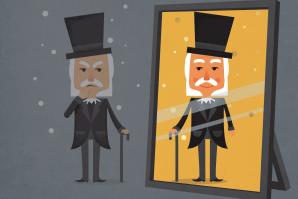Tania Fowler, owner and founder of Interplay Coaching, is a business coach focused on working with executives and their teams to help drive stronger team engagement and performance. She is an expert on improving team dynamics and outcomes, opening up communication channels, building leadership and management capabilities, MBTI Temperament and Interaction Style patterns and The Five Dysfunctions of a Team facilitation. On Twitter @SactoCoach.
By this person

Breaking the Habit
Toxic patterns abound in the workplace — but you can change them
As I write this, I am seated by the window on an airplane flying east. Taking off over Sacramento, acres and acres of green and brown agricultural fields come into view. Each block of squared-off land is juxtaposed against another, all cut into varying diagonals and straight lines, forming an intricate pattern of rich farmland.

Don’t Let Groupthink Rule Your Workplace
The best leaders encourage their team members to challenge questionable ideas and assumptions
Groupthink is all too common when people work together in a brainstorming or planning session. This phenomenon can veer a team or company off course, or it can result in people stereotyping others, including their colleagues — neither is good for a company.

Visualize Your Strategy
How storyboarding can help your team create a strategic plan
Are you the kind of person who thinks in pictures? If so, then storyboarding is for you. Are you the kind of person who doesn’t think in terms of pictures? If so, then storyboarding is for you, too — you may just not know it yet.

Ask Yourself: What’s Your Why?
Finding our purpose in life will make us better leaders
If you don’t think about your reasons, if you don’t make plans for yourself, someone else is most assuredly waiting in the wings to make a plan for you. You can count on it.

Leadership Can Happen Unexpectedly
Look for random acts of courage — and encourage them
While there are a mountainous number of books and articles about leadership — on the traits and qualities of good leaders, what it takes to be a leader and whether everyone is capable of being a leader — it’s important to remember that leadership boils down to a couple key things: followers and a crystal clear message. To keep the followers, you need to get the message right.

How to Build Your Team
Such important work requires patience and ongoing communication
The single biggest strategic advantage you have when it comes to outperforming your competitors is a highly effective team. A great team wins. Now let’s examine what teams look like when they are not working well:

Start the New Year with a New Mindset
There’s no better time for self-reflection for yourself and your team than now
It is important to remember we are all more than the money we make. People want to know how they contribute to some greater good, so if you haven’t already, start with creating a clear vision of how your company makes an impact.

Is Your Business Locked into Narrow Thinking?
The space between the either/or continuum is full of unexplored option
Have you heard the riddle of a father and son who get in a horrible car crash that kills the dad? The son is rushed to the hospital and the surgeon exclaims, “I can’t operate, that boy is my son!” The listener’s expectation is challenged when the riddle’s answer is given: The surgeon might be the boy’s mother.

The Value of Customer-Centered Strategies
Putting clients first can ensure the longevity of your business
In those early days of Disneyland, Walt hired Van France to establish Disney University and hire and train the “cast” (employees) that would bring the theme park to life. France reinvented the training and development of employees with his carefully crafted Four Keys (now more commonly known as Crystal Clear Priorities, aka CCPs).

Trust the Pattern
Reliability is the most important factor in establishing trust
Lately, with the news worldwide being somewhat bleak, I thought I’d write about trust -— since it seems to be waning a bit. Trust is something we commonly talk about in business, in leadership, in politics. It’s something we aspire to build and yet still seems challenging to grasp. So here’s my attempt to define trust and how it manifests in our lives.

Boundaries or Bust
Assertively draw these metaphorical lines
Boundaries are the metaphorical lines we draw to ensure we don’t slip into doing things that counter our value systems. Having clear boundaries prevents other people from taking advantage of you and helps you keep your distance from possible dubious activities. While there are no hard-and-fast rules for setting your boundaries, these tips may be helpful.

Do Ask; Don’t Tell
Cultivate employee strengths by asking more questions
If I have learned one thing by working with people in organizations, it’s that there’s much more telling than asking going on. As a business coach, my clients will expect me to ask, at some point in their session, “So what’s the question?”

Meetings That Matter
Keep your staff engaged by making the most of your time together
Meetings are the organizational fulcrum where individuals work together cooperatively as a team. At their best, good meetings get people’s brains fired up. At their worst, meetings provoke a fight-or-flight instinct in the poor souls gathered at the table — they shut people’s brains down.

Sweet, Sweet Reward
Celebrating team successes is essential to further productivity — and employee satisfaction
Thoughtful leaders build teams and environments where people get stuff done effectively. Celebrating the successful efforts of employees is a great way to encourage future successes. What else do celebrations reinforce?

Would You Like To Work For You?
Putting yourself in your employees’ shoes will make you a better leader
Here’s an idea I share with my clients: We don’t actually get to decide what kind of leaders or communicators we are. Instead, the people in our lives decide the degree to which they value our impact. Whether you lead or manage people, look now through your employees’ eyes and ask, “Would I want to work for me?”

The Power of Failure
Getting it wrong builds resiliency, courage and confidence
Working hard to achieve something new should not be fodder for punitive action; it’s the maintenance of a poorly functioning status quo that should be looked at with a sideways glance. Perfection lives on the same continuum as failure. In life, as in work, we learn painfully but fully from our failures — that is when we grow.

The Masked Agitator
Don’t let toxic employees manipulate you into poor leadership
Toxic people don’t lack insight into their behavior — they lack motivation to change it. Instead, they spend their time gaming bosses, employees and jobs to their own advantage and the detriment of others. Leaders need to deal with them as soon as a problem arises with clear communication and accountability measures. If the bad behavior persists, they need to go.

When I Was Your Age…
Navigating the generation gap, again
People will inevitably adapt to the demands that new technologies bring. They say that children born today will never have to learn to drive a car. Instead, they will learn to do things no adult generation today can yet imagine. It has always been this way, since the first caveman discovered fire and invented tools. Each preceding generation has something to do with the inventions that are passed on to the next. So why all the intergenerational demonization?

Difficult Employees with Good Intentions
Don’t give up on a great worker who can’t communicate
You might experience a scenario like this at the office: A colleague, boss or employee is incredibly gifted; they are technically skilled, knowledgeable, strategic and very smart. But a frustrating paradox is that they are terrible communicators: unable to take on other’s perspectives, constantly interrupting and long-winded, putting themselves ahead of others, defensive, inflexible, emotional — you get the drift.

From the Dinner Table to the Board Room
How three local family businesses make it work
Some families love being together, some enjoy short visits and others have a hard time just getting through Thanksgiving dinner. So how do families who have decided to go into business together make it work? Recently I had sat down with three families-turned-business-partners to find out.

Is Your “Be Like Me” Mentality Hurting Your Team?
It takes both introverts and extroverts to keep the office humming
We are all born with preferences for introversion and extraversion. Some of us sit in the middle of the continuum (ambiverts), but people typically fall into one of these two categories. And you might be surprised by how the two different groups perceive one another.

The Hard Truth on Trust
Leaders, trust starts at the top
Trust is often at the heart of what goes right and what goes wrong. Strong trust leads to constructive conflict while poor trust invites elephants into the room. When a company has a culture of trust, people keep their commitments. In its absence, team members become unreliable and productivity drops.

Directing versus Informing: The Dual-Language Quagmire
Successful communication hinges on the ability to meet in the middle
Scenario: You open the refrigerator to find a near-empty milk carton. What would you tell your partner or roommate? Whether you would say, “Get milk when you go out,” or something more like, “Hey, we’re out of milk,” can tell you a lot about your communication style.

Smarty Pants Don’t Always Fit
Critical thinking and communication skills are more valuable than fancy credentials
Hiring is a confounding game. Some people have a great knack for it and an intuitive sense about people — but even they can get it wrong. The world-renowned Disney Institute hires “attitude versus aptitude,” and you would be wise to do the same.

More Asking, Less Telling
How you talk to your employees matters
Quality communication goes far beyond organizational structures, clear directives and efficient systems. Time and again, I’ve watched highly effective teams crumble due to a lack of effective dialogue. And that’s because the most successful way to engage and improve your company is not by talking. It’s by listening.



